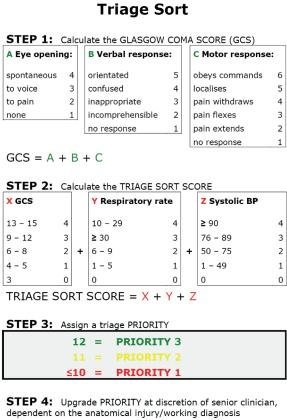S3E4: Major Incident - PHEM/MISC
We’ve got a big case for you this month, folks — join us as Leah, Joe and Deirdre take us through the management of a mass casualty incident.
Dr Jason van der Velde is our Adult in the Room to give his insight on this complex topic.
It’s all hands on deck for this one.
What exactly is the definition of a major incident?
This is any event where the number of casualties and the rate at which they occur cannot be handled within the normal routine service arrangements. They overwhelm local services and resources.
Injuries can be traumatic or medical, for example in chemical exposures. They can have multiple injuries.
The goal is to maximise the chances of reducing mortality and morbidity by effective utilisation of resources. There is a HUGE amount of organisation involved in dealing with these major incidents, as you’ll see in this case.
Let’s orientate ourselves.
An evening train has derailed in a rural area- what’s the first thing to do for our on-scene paramedics?
Confirm visual report stating if the emergency is standby or declared
The driver will pull up, leave the lights on, and act as a communications officer until one arrives
Scene survey — person two will carry out the scene survey and send a methane message to control room
Methane Message
Here’s our METHANE message for this case:
M- MAJOR EMERGENCY DECLARED
E- outside O’Reilly’s farm
T- train derailment
H- metal, glass, electricity
A- access to the area is via local road or good access from air
N- 75
E- Emergency services on scene or needed
CSCATT - a helpful tool for triage
Here in emergency medicine, we love a good structured approach. CSCATT (Command, Safety, Communication, Assessment, Triage, Treatment, Transfer) can be used both pre-hospital and in the ED.
Triage categories
We need to have a means of assessing how currently physiologically stable a patient is. Current is important because triage should be fluid and repeated. Don’t forget, the walking well can eventually lose their output.
Triage once, triage again, triage a third time for luck.
ATACC 2014 makes any catastrophic haemorrhage a T1 (red) and should be prioritised for treatment and transport. Anyone who is unconscious but has a patent airway and is breathing or conscious with a RR below 10 or above 30 are also T1. Red category patients need to be prioritised for transport. They need urgent care within minutes to one hour.
If they are conscious and tachycardic >120bpm or have a delayed cap refill, they can also be escalated to this even if their respiratory rate is normal. Anyone conscious but not walking with normal vital signs would be made a T2 (yellow). Yellow patients will deteriorate if not seen to within the first few hours. Delays might increase both morbidity and mortality.
The walking injured are green or T3 (green).
The non-injured would be directed to a survivor reception centre and marked as T4s (blue).
Anyone without a patent airway or evidence of breathing on initial assessment is marked as black or deceased.
It’s important to remember that there is no role for CPR in the MCI scenario.
How to prep your ED
Pre-hospital crews are on scene and the first casualties are expected into ED in 15 minutes - what’s the best way to get you and your team prepared for the long night ahead?
Hopefully you’ve had a read of the Major Incident Plan in your hospital, but if not, this will be your bible. There will be small differences in each plan from hospital to hospital, so it's definitely worth asking your manager to have a look at it and knowing where to get it.
The HSE has a Framework for Major Emergency Management, and has created individual Emergency Plans for Emergency Management Areas which are grouped by county. The aim of these is to provide a framework, skills base and tools to respond to any Emergency that may arise. These emergency plans are designed to link in with other government services that may be involved depending on the type of major incident. We've added a link below so you can have a read of the one that pertains to the area where you work.
Preparedness
When it first becomes apparent that there is or may be a Major incident, communication is key - confirming there is a major incident and communicating with staff within your own department. In conjunction with the department CNM and consultant in charge, the ED team is gathered and prepped for the hours ahead.
We're used to assembling a trauma team and pre-alerts, but how can we co-ordinate it on such a large scale? Assigning roles is key - non ED clinicians may arrive to help and it is important they are assigned roles and understand the description of their role. Having someone specifically assigned to manage this optimises organisation.
The sheer volume and speed of patient's arriving has the potential to overwhelm any ED. Discharging patient's who are well with appropriate follow up and safety netting advice, and transferring patients who require admission to the ward should happen in the first instance.
Be mindful of the psychological safety of your staff
Always important to have a thorough debrief after an incident like this before everyone goes home. Major incidents are very taxing both mentally and physically on staff, and junior colleagues especially may not have had as much exposure to such events.
West Cork Rapid Response Fundraiser
https://www.gofundme.com/f/2q7cq6g7vc
Make sure you head over to that link to read about and support the amazing Olivia Keating’s fundraiser for West Cork Rapid Response.
References
New NHS Prehospital Major Incident Triage Tool: from MIMMS to MITT - https://emj.bmj.com/content/39/11/800
Methane Message: https://em3.org.uk/foamed/18/7/2018/major-incident-management
https://naru.org.uk/wp-content/uploads/2016/06/Prehospital-organization-and-management-of-a-mass-casualty-incident-.pdf
https://www.researchgate.net/figure/NASMeD-Triage-Seive_fig1_276883276
CSCATT: https://clinicalgate.com/the-major-incident/
HSE Major Emergency Plans by Area - https://www.hse.ie/eng/services/list/3/emergencymanangement/area-mep/
https://www.stemlynsblog.org/



